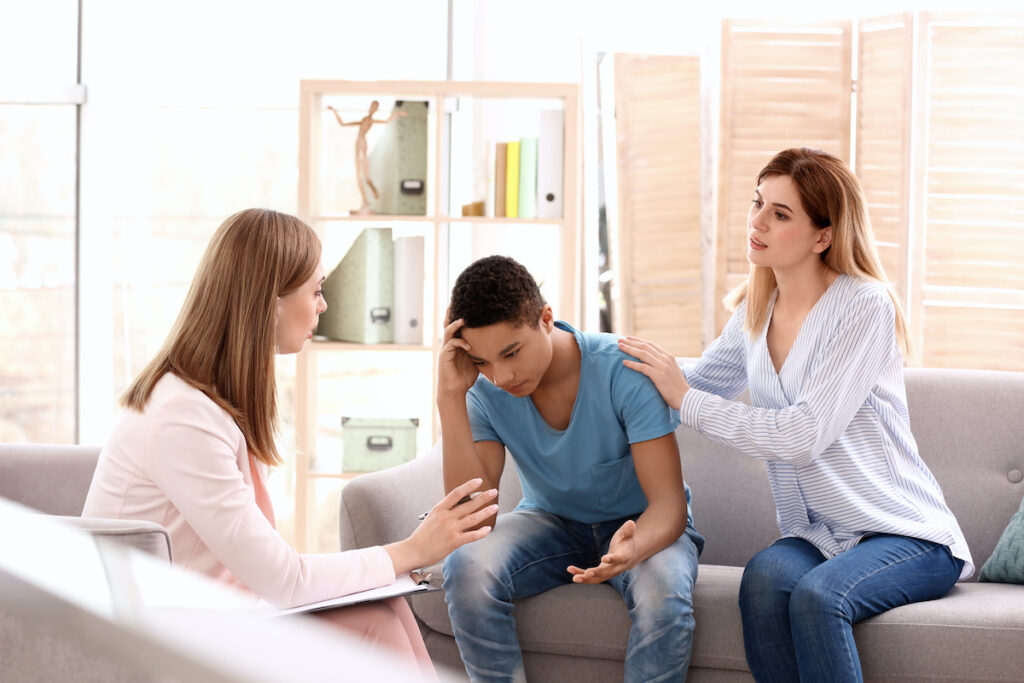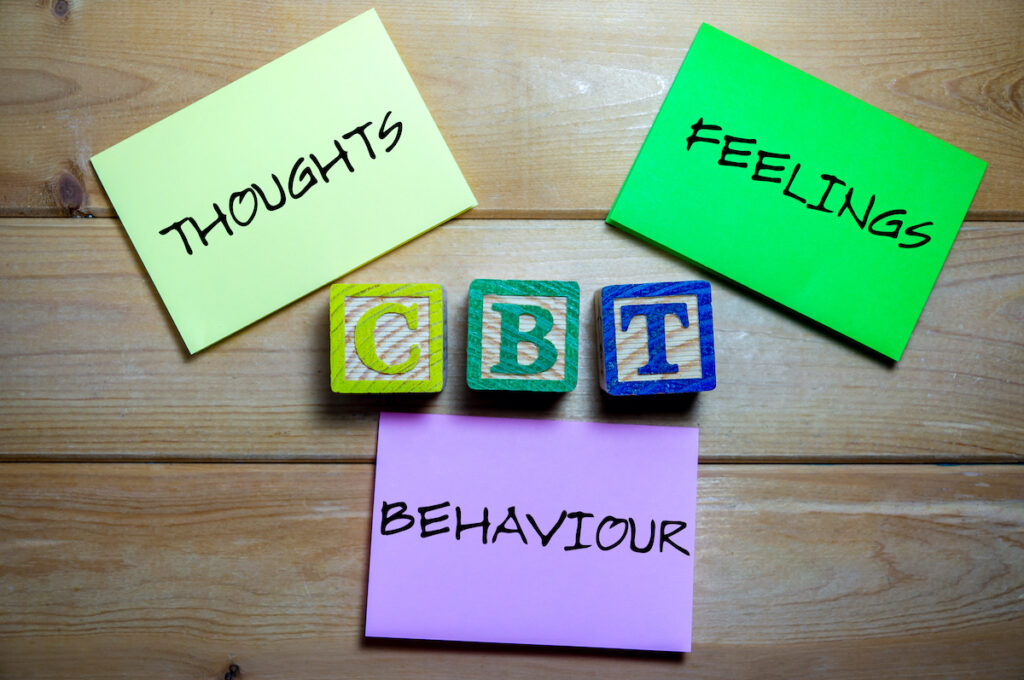
Anxiety disorders in adolescence can have long-term impact if left untreated (Woodward, 2001). Cognitive Behavioural Therapy (CBT) is recommended as the first line of treatment for adolescents with anxiety disorders. Research has suggested that adolescents have lower remission rates from CBT compared to children (Ginsburg et al. 2011). Therefore, CBT must be developed upon to provide adolescents with a more efficacious treatment. Cardy et al. (2020) suggested that the involvement of parents in a therapeutic setting could help to improve the outcomes of CBT for adolescents.
Cardy et al.’s (2020) study outlines several theoretical reasons as to why parents might need to be involved in different ways in CBT for adolescents as opposed to CBT for children: adolescents have an increased drive for autonomy, capacity for abstract reasoning, self-awareness and self-reflection, and research has also indicated differences in patterns of parent-child and parent-adolescent interactions in the context of anxiety. Despite this theoretical background, there is a lack of clarity over the unique ways in which parents should clinically be involved (Barmish and Kendall, 2005).
Cardy et al. (2020) are the first to focus on the involvement of adolescents’ parents in CBT for anxiety disorders. This paper has three aims relating to CBT for adolescent anxiety:
- To outline the ways in which parents have been involved
- To explore the outcomes when parents are involved
- To investigate whether parental involvement is associated with better outcomes compared to when parents are not involved.

There is a lack of clarity over how, and whether, parents should be involved in CBT for adolescents with anxiety in clinical practice, thus Cardy et al. (2020) set out to review the existing literature.
Methods
The authors searched five databases (PsycINFO, Embase, CINAHL, Medline and AMED). The study adhered to PRISMA guidelines, and the search was completed in January 2019. Sample inclusion criteria were that participants had at least one anxiety disorder diagnosis (as defined by DSM-5, thereby excluding OCD and PTSD) and that the whole sample was aged between 11 and 18. With regards to CBT, it must have been the primary treatment for the adolescents’ anxiety disorder, and there must not have been any additional components from other therapeutic approaches. At a minimum, one biological parent must have been involved in the adolescents’ CBT in at least one arm of the study. Inter-rater reliability was checked and any uncertainty around the inclusion/exclusion criteria was resolved through discussion between the authors. Twenty-four studies met the inclusion criteria.
Downs and Black’s (1998) methodological quality checklist was used to give studies a rating of poor, fair, good or excellent. The original checklist was adapted to include an additional item “Did the study clearly describe parental involvement?”
The results of the search are outlined through a narrative synthesis, and the influence of parental involvement is measured by remission of primary diagnosis pre- and post-treatment, or changes in symptoms, using validated interviews and/or questionnaires.
Results
How have parents been involved in CBT for adolescents with anxiety disorders?
Parents have been involved through:
- Joining the adolescents’ sessions
- Attending sessions separate to their adolescent
- Completing a workbook to use throughout their adolescent’s treatment.
This involvement can be broken down into four main aims:
- Educating parents on the core components of CBT to help them understand and manage their adolescent’s difficulties. Specifically, parents have been provided with training in graded exposure and contingency management
- Involvement in treatment, for example through cognitive restructuring, problem-solving and relaxation training and relapse prevention planning
- Addressing parents’ beliefs that could be unhelpful, so that these beliefs do not interfere with treatment. In practice this involved talking about parents’ anxieties and fears regarding their adolescent’s autonomy and therapy.
What are the outcomes when parents are involved in CBT for adolescent anxiety disorders?
Twelve of the included studies were case studies or series. Six of the eight case studies/series that reported remission rates found a remission rate of 100%. Of the four studies that only reported outcomes on symptom measures, between 88 and 100% were found to be in the ‘non-clinical’ range post-treatment. Six of these studies included follow-up and the reductions in anxiety were maintained for up to 12 months.
The remaining 12 studies were randomised controlled trials (RCTs). While 11 of these RCTs found significant benefits to treatment compared to the waitlist or no treatment control, there was variability in remission rates (20-90%). With regards to follow-up, 7 of the 8 RCTs that followed up showed a greater number of adolescents in remission at follow-up than post-treatment.
There was no clear pattern of effect according to the format or content of parent involvement. The review notes that few studies measured treatment acceptability in a systematic way. When parents were asked for feedback, this was positive except for one study where parents wanted more involvement.
Is parental involvement associated with better outcomes compared to when parents are not involved?
Only one included study compared outcomes of when parents are involved to when parents are not involved. This study found that parental involvement did not lead to significant improvements post-treatment or at 6-month follow-up. Further, dropout was double when parents were involved. However, parents reported to be more satisfied with the treatment, and there were lower rates of onward referral when parents were involved.

While case studies/series show promising results on parental involvement in CBT for anxiety, RCTs show significant variability in remission rates.
Conclusions
While parents have been involved in adolescents’ treatment for anxiety in a variety of ways, the only RCT allowing for parent involvement to be examined as a factor in treatment outcomes found that parental involvement did not significantly improve outcomes (Waite et al., 2019).

It is unclear whether, and how best, to involve parents in CBT for adolescents.
Strengths and limitations
As stated in the paper, the review contributes to the literature on anxiety disorders in adolescence. Whilst the authors did not register the protocol, methodological rigour was ensured by adherence to the PRISMA guidance, by using a quality assessment tool and by deciding the inclusion and exclusion criteria before the search was conducted. However, it is unclear why the authors adapted the quality assessment tool. The paper does a good job of the narrative synthesis by summarising all the different approaches used by different studies in a way that is easy to follow.
Just under half of the included studies were case studies/series and therefore, by nature, have a small sample size. This makes it hard to draw conclusions, especially when we consider publication bias, as there is an increased possibility that only cases with positive results have been published. Although the remaining studies were RCTs with larger sample sizes, all but one used a waitlist or an active control group and did not compare to CBT without parental involvement. This makes it hard to disentangle parental involvement from other factors. For example, the wide variation in the mode of CBT offered (face-to-face, online, phone, group and family) makes it hard to understand the influence of parental involvement. While it is understandable that the authors wanted to include as many studies as possible, I believe that not enough is yet known about the efficacy of the different types of CBT to add that as another potential factor influencing the results.
The paper self-identified several limitations:
- Firstly, it states that several of the included studies did not identify their measure of interest before conducting the study, thereby running the risk of false-positives.
- Secondly, the authors note that their search could have missed data from studies that did not report parental involvement or specific, pre-defined treatment components.
- The review could further have missed data as it did not search for grey literature and only included studies written in English.
- Further, it is not clear why studies were excluded that included pharmacotherapy in their treatment approach. Some adolescents will be prescribed medication even though it is not the first line of treatment, and so I imagine this could have excluded many studies.
- Lastly, the paper notes the poor reporting of recruitment processes and sample demographics. As is best practice, the review authors could have contacted the study authors to gather this missing data.

The wide variation in the mode of CBT offered (face-to-face, online, phone, group and family) makes it hard to understand the influence of parental involvement.
Implications for practice
Think about your parents; think about being in your teens; would you want them to be involved in your therapeutic journey? I imagine that there would be a wide variation of responses to this question.
I agree that research in this area is highly needed, so that clinicians can understand how to best involve parents in therapy/treatment for adolescents. However, I think that the question of whether parents should be involved must be addressed on an individual basis. Researchers should offer the opportunity for adolescents voices to be heard. Therefore, I would argue that qualitative research would be the ideal next step in order to examine in-depth adolescents’ opinions on the involvement of parents in therapeutic treatments for anxiety, such as CBT. It would also be interesting to explore one of the findings of this review; the higher dropout rate from CBT when parents were involved. Why does this happen and how often?
The COVID-19 pandemic has highlighted the urgency to ensure that parents are involved in their children’s treatment in the most optimal way, as services are delivered digitally.

Adolescents should be given the opportunity to have a voice regarding parental involvement in their CBT for anxiety, so qualitative and further research in this area is needed.
Statement of interests
None.
Links
Primary paper
Cardy, J. L., Waite, P., Cocks, F., & Creswell, C. (2020). A Systematic Review of Parental Involvement in Cognitive Behavioural Therapy for Adolescent Anxiety Disorders. Clinical Child and Family Psychology Review, 1-27.
Other references
Barmish, A. J., & Kendall, P. C. (2005). Should parents be co-clients in cognitive-behavioral therapy for anxious youth?. Journal of Clinical Child and Adolescent Psychology, 34(3), 569-581.
Downs, S. H., & Black, N. (1998). The feasibility of creating a checklist for the assessment of the methodological quality both of randomised and non-randomised studies of health care interventions. Journal of Epidemiological Community Health, 52, 377–384.
Ginsburg, G. S., Kendall, P. C., Sakolsky, D., Compton, S. N., Piacentini, J., Albano, A. M., … & Keeton, C. P. (2011). Remission after acute treatment in children and adolescents with anxiety disorders: findings from the CAMS.Journal of consulting and clinical psychology, 79(6), 806.
Waite, P., Marshall, T., & Creswell, C. (2019). A randomized controlled trial of internet-delivered cognitive behaviour therapy for adolescent anxiety disorders in a routine clinical care setting with and without parent sessions. Child and Adolescent Mental Health.
Woodward, L. J., & Fergusson, D. M. (2001). Life course outcomes of young people with anxiety disorders in adolescence. Journal of the American Academy of Child & Adolescent Psychiatry, 40(9), 1086-1093.
Photo credits
- Photo by Jude Beck on Unsplash
- Photo by Vince Fleming on Unsplash
- Photo by Dylan Ferreira on Unsplash
